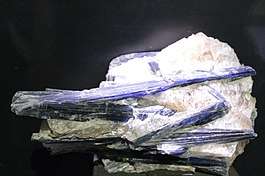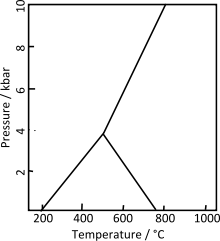Kyanite
Kyanite is typically a blue aluminosilicate mineral, usually found in aluminium-rich metamorphic pegmatites and/or sedimentary rock. Kyanite in metamorphic rocks generally indicates pressures higher than four kilobars. It is commonly found in quartz. Although potentially stable at lower pressure and low temperature, the activity of water is usually high enough under such conditions that it is replaced by hydrous aluminosilicates such as muscovite, pyrophyllite, or kaolinite. Kyanite is also known as disthene, rhaeticite and cyanite.
| Kyanite | |
|---|---|
 | |
| General | |
| Category | Nesosilicate |
| Formula (repeating unit) | Al2SiO5 |
| Strunz classification | 9.AF.15 |
| Crystal system | Triclinic |
| Crystal class | Pinacoidal (1) (same H-M symbol) |
| Space group | P1 |
| Unit cell | a = 7.1262(12) Å b = 7.852(10) Å c = 5.5724(10) Å α = 89.99(2)°, β = 101.11(2)° γ = 106.03(1)°; Z = 4 |
| Identification | |
| Color | Blue, white, rarely green, light gray to gray, rarely yellow, pink, orange, and black, can be zoned |
| Crystal habit | Columnar; fibrous; bladed |
| Twinning | Lamellar on {100} |
| Cleavage | [100] perfect [010] imperfect with 79° angle between |
| Fracture | Splintery |
| Tenacity | Brittle |
| Mohs scale hardness | 4.5-5 parallel to one axis 6.5-7 perpendicular to that axis |
| Luster | Vitreous to white |
| Streak | White |
| Diaphaneity | Transparent to translucent |
| Specific gravity | 3.53 - 3.65 measured; 3.67 calculated |
| Optical properties | Biaxial (-) |
| Refractive index | nα = 1.712 - 1.718 nβ = 1.720 - 1.725 nγ = 1.727 - 1.734 |
| Pleochroism | Trichroic, colorless to pale blue to blue |
| 2V angle | 78°-83° |
| References | [1][2][3] |
Kyanite is a member of the aluminosilicate series, which also includes the polymorph andalusite and the polymorph sillimanite. Kyanite is strongly anisotropic, in that its hardness varies depending on its crystallographic direction. In kyanite, this anisotropism can be considered an identifying characteristic.
At temperatures above 1100 °C kyanite decomposes into mullite and vitreous silica via the following reaction: 3(Al2O3·SiO2) → 3Al2O3·2SiO2 + SiO2. This transformation results in an expansion.[4]
Its name comes from the same origin as that of the color cyan, being derived from the Ancient Greek word κύανος. This is generally rendered into English as kyanos or kuanos and means "dark blue".
Uses
Kyanite is used primarily in refractory and ceramic products, including porcelain plumbing and dishware. It is also used in electronics, electrical insulators and abrasives.
Kyanite has been used as a semiprecious gemstone, which may display cat's eye chatoyancy, though this use is limited by its anisotropism and perfect cleavage. Color varieties include recently discovered orange kyanite from Tanzania.[5] The orange color is due to inclusion of small amounts of manganese (Mn3+) in the structure.[6]
Kyanite is one of the index minerals that are used to estimate the temperature, depth, and pressure at which a rock undergoes metamorphism.
Notes for identification
Kyanite's elongated, columnar crystals are usually a good first indication of the mineral, as well as its color (when the specimen is blue). Associated minerals are useful as well, especially the presence of the polymorphs of staurolite, which occur frequently with kyanite. However, the most useful characteristic in identifying kyanite is its anisotropism. If one suspects a specimen to be kyanite, verifying that it has two distinctly different hardness values on perpendicular axes is a key to identification; it has a hardness of 5.5 parallel to {001} and 7 parallel to {100}.[1][2]
Occurrence
Kyanite occurs in gneiss, schist, pegmatite, and quartz veins resulting from high pressure regional metamorphism of principally pelitic rocks.[7] It occurs as detrital grains in sedimentary rocks.[7] It occurs associated with staurolite, andalusite, sillimanite, talc, hornblende, gedrite, mullite and corundum.[1]
Kyanite occurs in Manhattan schist, formed under extreme pressure as a result of the two landmasses that formed supercontinent Pangaea.[8]
References

- Specific citations
- "Kyanite" (PDF). Handbook of Mineralogy. 2001. Retrieved 2018-01-01.
- "Kyanite". MinDat. Retrieved 2013-06-14.
- "Kyanite Mineral Data". Webmineral.com. Retrieved 2013-06-14.
- Speyer, Robert (1993). Thermal Analysis of Materials. CRC Press. p. 166. ISBN 0-8247-8963-6.
- M. Chadwick, Karen; R. Rossman, George (2009-01-01). "Orange kyanite from Tanzania". Gems and Gemology. 45.
- M. Gaft; L. Nagli; G. Panczer; G. R. Rossman; R. Reisfeld (August 2011). "Laser-induced time-resolved luminescence of orange kyanite Al2SiO5". Optical Materials. 33 (10): 1476–1480. Bibcode:2011OptMa..33.1476G. doi:10.1016/j.optmat.2011.03.052.
- "Geology Page - Kyanite". Geology Page. 2014-05-16. Retrieved 2020-02-20.
- Quinn, Helen (6 June 2013). "How ancient collision shaped New York skyline". BBC Science. BBC.co.uk. Retrieved 2013-06-13.
Prof Stewart was keeping an eye out for a mineral known as kyanite, a beautiful blue specimen commonly seen in the Manhattan schist. 'Kyanite is a key mineral to identify, we know it only forms at very deep depths and under extensive pressure,' he said. 'It's like a fingerprint, revealing a wealth of information.' The presence of this mineral reveals that the Manhattan schist was compressed under incredibly high pressure over 300 million years ago. The schist formed as a result of two enormous landmasses coming together to form a supercontinent, known as Pangaea.
- Whitney, D.L. (2002). "Coexisting andalusite, kyanite, and sillimanite: Sequential formation of three Al2SiO5 polymorphs during progressive metamorphism near the triple point, Sivrihisar, Turkey". American Mineralogist. 87 (4): 405–416. doi:10.2138/am-2002-0404.
- Whitney, D.L. (2002). "Coexisting andalusite, kyanite, and sillimanite: Sequential formation of three Al2SiO5 polymorphs during progressive metamorphism near the triple point, Sivrihisar, Turkey". American Mineralogist. 87 (4): 405–416. doi:10.2138/am-2002-0404.
- General references
- Mineral Galleries
- Faye, G. H.; Nickel, E. H. (1969). "On the origin of colour and pleochroism of kyanite" (PDF). The Canadian Mineralogist. 10: 35–46.
External links
| Wikimedia Commons has media related to Kyanite. |
- . Encyclopædia Britannica (11th ed.). 1911.
